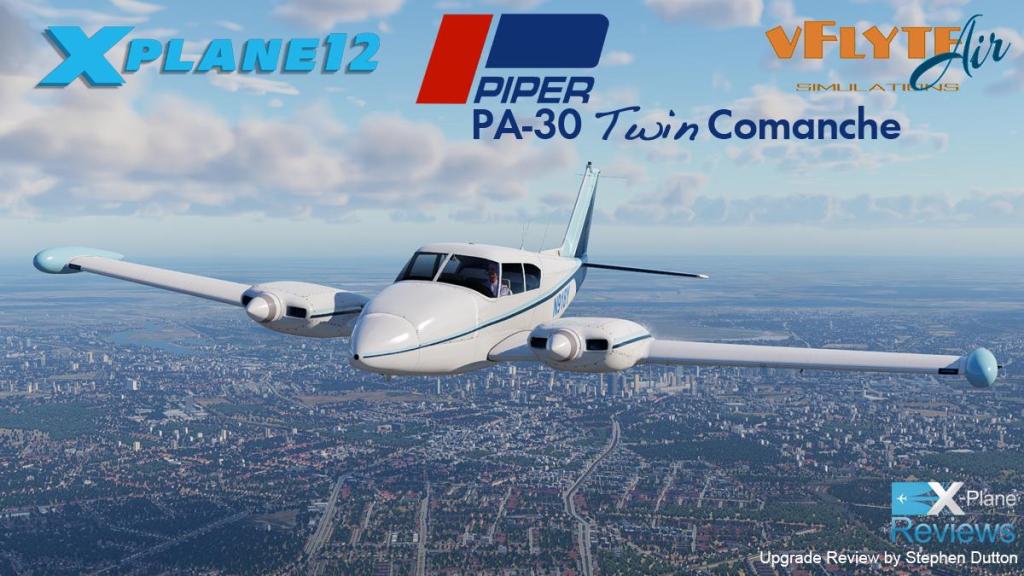Search the Community
Showing results for tags 'vflyteair simulations'.
-
Aircraft Update Review : Piper Twin Comanche PA30 X-Plane 12 by vFlyteAir Simulations Just a week out from the Houston FlightSimExpo 2023. vFlyteAir Simulations released three aircraft upgraded to X-Plane 12. As vFlyteAir are based in Texas, then there is a good chance they will be at the Expo, so say hello. The important aspects behind vFlyteAir Simulation's philosophy. Is that all their aircraft have been designed around a real donor machine, so the results are perfect imitations of the real aircraft. vFlyteAir not only reproduce the aircraft, but perfect their performance and flying dynamics for Simulator flying and training. Our look in this review is at one of the released upgraded aircraft that is the PA-30, Piper Twin Comanche. The aircraft has been totally rebuilt from the ground up for X-Plane 12 (good news as the X-Plane 11 version was feeling a bit dated). Price is noted as an upgrade, so you have to repurchase the aircraft for this only X-Plane 12 version (but X-Plane 11 purchasers get 40% off the price). However the features have been upgraded as well. Twin Comanche is a low-wing cantilever monoplane with a retractable tricycle landing gear. It comes with tip tanks which allows the aircraft to hold 120 gallons (454 l) of fuel. Fuel burn at typical cruise settings is approximately 16 gph (58.7 lph) with a cruise speed of 165 kts. It easily climbs to 18,000 feet (5,500 m) when desired (24,000 feet (7,300 m) if turbocharged). When compared with the Seminole, the Twin Comanche goes faster, carries more, burns less fuel, is quieter, climbs more rapidly and ultimately higher. With the tip tanks attached it has a range of 1200 miles (1931 km). The Twin Comanche was produced from 1963 in the same Lock Haven, Pennsylvania production line as its single-engined cousin; production ceased when the factory was flooded in 1972. Piper chose at that time to focus instead on its equally popular Cherokee 140/180/235/Arrow line, an aircraft that was manufactured in Florida. First impressions are brilliant. The PA-30 looks very different in X-Plane 12 compared to X-Plane 11, vibrant, more realistic. It looked good in X-Plane 11, don't get me wrong on that point, but here it totally shines. The aircraft to a point also needed a bit of help, although an early 60's design, the Comanche in design can feel dated, but I feel the new X-Plane 12 dynamics in lighting changes that aspect. VflyteAir's perfect modeling helps enormously, here redone completely from the ground up... so you really feel, see the update and the improvements. I am genuinely surprised on how much better this aircraft looks in X-Plane 12. Certainly already the panel fit, riveting and superb detailing as that was a given and all with PBR textures, but it just all feel so much better here, all a big tick from me. This is the thing about X-Plane 12, yes it can elevate most aircraft, but developer tuned aircraft to the new lighting dynamics really do stand out. Engine air vents can still be closed, or opened again if the temperatures start to rise. Versions: Steam Panel and Glass Panel The X-Plane 11 Twin-Comanche came with only one version... a standard analog instrument panel. Here now though with the X-Plane 12 release you get two choices, first we will look at the original... Steam Panel. Steam Panel The analog instrument panel in design is not changed from the original XP11 facia. Massively lovely inset standard flying instruments. VOR-1 with Glideslope indicator and a KRA 405B RADAR Altimeter left and to the right four (twin) Engine gauges (RPM/CHT/EGT/MANIFOLD/FF) dominate the panel with a far right side box of Fuel/Oil gauges, and a good avionics stack makes this a really nice layout. It is a layout I really like a lot as it is all very period original and authentic. Notably all the magneto switches and starter switches are now located on the lower left of the instrument panel. The analog equipment stack is exactly the same. Radio is a PS Engineering PMA8000Ti, then the standard Garmin GNS530. Then a Bendix/King KX 155 COMM2/NAV2 radio (COMM1/NAV1 is part of the GNS530). The Avidyne AXP340 transponder is a nice bit of kit, it covers the transponder, with Pressure Alt, Flight Time, Stop Watch and Flight ID as part of the system. A very nice looking Voltmeter and fuses panel is still set below the transponder. Glass Panel The "Glass" panel was promised for the X-Plane 11 PA-30 aircraft but was never installed (actually the Aspen, but changed here). Now you have a separate (.acf) aircraft noted for this glass option. Here you have a vFlyteAir custom Garmin G5 PFD/HSI (stacked) combination Primary Flight Display. With another electronic feature of a Garmin TXi touch-screen Engine Information System (EIS), with built in Lean Mode. In reality the G5 system replaces the central PFD (Artificial Horizon) and lower HSI (Heading Indicator) with electronic (Glass) versions... Both pop-out for convenience and ease of use. G5 ADI Page displays - Artificial Horizon, Airspeed (tape), attitude (tape), altitude, vertical speed, heading, and course deviation information (CDI) The G5 unit is a bright, sunlight readable, 3.5-inch color display. In the case of aircraft power loss, the G5 battery sustains the G5 flight display with up to (4) hours of power. Battery back-up power and battery recharge and is fully simulated here. There is also a "On" system power-up, and an power-on introduction screen which will appear briefly during system initialization. Another feature is G5 failures, and annunciations will be shown to indicate the nature of the failed system. PFD G5 ADI Page displays - Artificial Horizon, Airspeed (tape), attitude (tape), altitude, vertical speed, heading, and course deviation information. There is a lot of built in menus... but first press the power button and you can adjust the screen brightness via the knob... Pushing the right adjustment knob (centre), brings up the PFD menu, there are five adjustment options - Heading, Altitude, Pitch, Baro and ESP (Electronic Stability and Protection ). There is another (hidden) Configuration Menu. You access the Menu by turning the power off? Hold down the power button until the system shuts down. Then repress the power button for 2 Secs to enter Configuration Mode. There are two options in Configuration Mode; "Airspeed" and "Units Configuration". Airspeed sets/changes the Airspeeds (V-speeds), and there are two pages of airspeeds you can change... Units Configuration sets/changes - Altitude (Feet/Meters), Distance (Nautical/Metric), Airspeed (knt/mph/kph),Groundspeed (knt/mph/kph), Vertical Speed Units (Feet/Meters per minute) and Pressure (in hg/mb/hPa). All done then select "Exit Configuration & Reboot" to exit the Configuration Mode, the system will then restart the Garmin G5 system to normal. HSI The lower HSI (Horizontal Situation Indicator) also has a menu system. Pressing the power button, you can again adjust the display brightness. Pushing the right adjustment knob (centre), brings up the HSI menu, there are five adjustment options - Heading, Altitude, OBS/Course (Omni-Bearing Selector), Bearing Pointer, PFD and Setup. Selection of Heading, Altitude and OBS is directly changing the action... here is OBS or Course (direction) adjustment. Selecting PFD will put the upper Primary Flight Display in the lower display.... Selecting Bearing Pointer will bring up the Bearing Circle, and used with... ... the two bearing pointers. The pointers are selected and changed in the "Setup". There are four options per pointer - None, VLOV1, VLOC2 and GPS1 So the Garmin G5 Electronic Flight Instrument system here is used with the Garmin GFC500 Autopilot controller head with popup window, set mid panel. The GFC500 panel also pops out for your convenience, and is seriously nice to use. Garmin EIS Garmin TXi Engine Information System (EIS) is a display and sensor system with a touch-screen control option. The EIS panel can be popped out, moved and scaled from a small to large display. The EIS displays engine, Electrical, and Fuel information. In this configuration for a twin-engine airplane, engine information provided includes - Manifold Pressure, Engine RPM, Oil Pressure, Oil Temperature, Exhaust Gas Temperature, and Cylinder Head Temperature. Turn the outer knob to highlight the EGT left or right temperature display box, or alternately, tap the desired EGT temperature display box to select it. The Fuel QTY (Quantity) is also selectable. Like the Garmin G5, it also has a configuration menu; "System - Units" menu with three selections - Fuel (GAL/LTS), Pressure (PSI/IN HG), Temperature (ºF/ºC)... "Engine" with three selections - EST Fuel Quantity Remaining, EST Fuel Quantity from Gauges, and Select Lean Mode. The last selection will change the digital display to "Lean Mode". During Lean Mode, cylinders are not selectable. The hottest cylinder is shown with a white bar. As the engine is leaned, a white peak “saddle” (horizontal bar) will move vertically up the graph until a peak EGT value is reached. After peak is reached, the “saddle” will stay at the peak value. As the cylinder temperature decreases below peak value, a reference value will appear the top right of the graph. The reference value indicates the EGT drop from peak value. Glass avionic stack is slightly different. Top is the same PS Engineering PMA8000Ti radio, below the standard Garmin GNS530 (VOR1). Then a more modern Garmin GNC 255 COM2/NAV2 radio with automated station ID lookups for both COM and NAV stations (nice)... finally lower is the same excellent Avidyne AXP340 transponder. Highlights of the cabin include those authentic rectangle shaped Yokes with central "Piper Comanche" logo, dirty as hell, worn but seriously nice, but no PTT button on these dated controls. Headset if selected will lower the cabin noise by 4db, nicely done, as are the different sets of rudder pedals, with the custom Piper left, and only bars right. Cabin is 60's original, with a single rear bench seat and two forward chairs, lovely headlining is also very vintage. Cabin in materials is off white leather with darker grey internals and grey walls. Love the roof positioned chrome pitch trim winder, and the drop down window shades are very dinky. Thankfully gone is the in your face pop-up instrument panel, horrible from the start, I'm glad its not in here anymore. But most displays and avionics pop-out for convenience, helpful as the G5 combo can be hard to read. _________________ The basic Twin-Comanche is powered by two 160-hp (119-kW) Lycoming IO-320-B1A engines in wing-mounted nacelles. Sounds obviously come from a donor PA-30 aircraft, so you have full circular doppler and spatial effects in FMOD 2.2 mode. In other words excellent. Naturally all X-Plane 12 rain and ice effects all work and are very effective and realistic. Dynamically the Comanche flies like a dream, you would be very disappointed if it didn't coming from vFlyteAir. But once behind the controls the aircraft responds perfectly to your commands, nice banked turns, it climbs well at 1,460 ft/min (7.4 m/s), mostly your pitch is around 1,200 fpm)... a Maximum speed of 205 mph (330 km/h, 178 kn), with a Cruise speed: 178 mph (286 km/h, 155 kn) (in a long range cruise)with tip tanks, 165 normal cruise. It is a beautiful aircraft to fly, better in X-Plane 12. Two points however I will make. One is that compass turns under the GFC500 autopilot, are very, very wide, even only a 2-3 degree turn, so you have to plan well ahead, or take manual control, do the tighter degree turn then reset the GFC500 at the new heading. Second point is that there isn't a lot of throttle response. Power up and the aircraft takes awhile to respond, worse is landing as you can't use the throttles to control the descent. I even found under the V/S Vertical speed, if you reduced power the PA-30 actually balloons upwards? so you feel a little disconnected from the aircraft when descending and landing in feel, if you like me fly by throttle inputs, it's tricky to get right at first, until you are used to it. Here both points are highlighted, the 2º turn, and the ballooning on the approach... Under carriage detail is amazing... in the animation and the quality of the gear. All the three wheels and hubs are nicely worn and worked, and the hydraulic piston with gear support is perfect. The ballooning made me long in the landing, but control at the flare point was perfect, slight nose up at 65 knts, and the Twin-Comanche will sink nicely... .... into a smooth landing. So the PA-30 has a sort of interesting flight dynamic you will need to get your head around, to get perfection. _________________ Menu The Twin-Comanche menu is all new for X-Plane 12. Gone are the four separate menu pages, replaced by three options in one menu with tabs. You can bring up the menu via either the "Piper" tab lower left of your screen, or from the Plugins/vFlyteAir Twin Comanche Menu in the X-Plane banner. Three tabs cover - "Options", "Load Manager" and "Checklist"... the old "Power Setting Table" is gone. Options In the "Options " panel you have eleven options - Select Pilot Gender, Show/Hide Gauge Glass, Show/Hide Window Glass, Toggle Shake effects, Ground Elements, Show/Hide Passengers, Show/Hide Tablet, Use Tow Bar, Fuel Selectors, Start from Cold & Dark and Pre-Flight Walkaround. You can switch to either a male or female pilot, both extremely well done and both the pilots are fully animated. Reflections in both Instrument and window glass can be made clear. "Toggle Shake Effects" are excellent, shake/vibration effects based on engine speed, stalls, and touch-down events are all very realistic, they can also be turned on or off. Ground Elements are all or nothing... not my favorite option as I like to use parking items like chocks separately? You do get Tie-Downs, Engine Inlet covers and Chocks... If you are dumb enough to try to takeoff with the elements showing, the menu will pop-up and place an arrow on the Ground Element option. There are two passengers in the rear, again a male and a female. Quality of the figures and animation is outstanding, developers have come a long way in presenting realistic pilots and passengers, but these are some of the best with smooth neck movements. You can Show/Hide all three in one click with this Show/Hide Passengers option. There is a "Tow Bar" option to manoeuvre the PA-30 on the ground... when selected you get a cross, that allows you to use your mouse to pull/push and turn the handle in the direction you want to go. The Twin Comanche's fuel selection panel is in a hard place to access, deep on the floor between the front seats. So for ease of selection the fuel selectors are placed on the menu. It's a good one with feeds between all the tanks. An option to "Start from Cold & Dark" is also available. Last option is the "walkaround".... here you can go point to point around the aircraft and check things like the fuel quantity, move/test flying surfaces, but note if you move the surface to a position, make sure it is returned to the neutral position as there is no auto reset? An odd trick here is that I was able to place the chocks in this mode individually! But still able to use the full option to clear them. Load Manager The X-Plane 11 PA-30 had a great Weights & Balances page, and you get the same here. You can show/hide any of the passengers (front and rear) and select all the persons on board with their own separate weight (but only in lbs)... baggage in the rear is also available by the amount of weight you dial in. Fuel is the same with six tanks available (Main/Aux/Tip) but again only in GAL (Gallons), this weight is then all shown on the CofG (Centre of Gravity) graph Both the main cabin door and baggage locker, have to opened manually, as is the small side window by the pilot. Checklists There is now a tab for checklists in - Pre-Flight, Starting, Taxi and Ramp, Takeoff, Climb and Cruise and Descent and Landing. You used to in XP11 tick off the boxes as you went through the lists, but you can't do that here. But you can now move and scale the checklist pop-out as compensation. _________________ Lighting As with all X-Plane 12 aircraft, the lighting is new. The adjustments however are the same, and very good they are. Instrument Panel lighting is very nice... at night, but the current X-Plane 12 bug of showing no lighting in the daylight is visible here, even with panel Lighting Posts. Not so in the dark as the panel just glows... More forward lighting can be had by using the overhead light, there is a second one more to the rear for the cabin... again forward is a red light for the overhead trim handle and compass, nice red glow feel down on the instrument panel as well. There are two knobs on the instrument panel that adjusts separately the brightness of instruments and the avionics. Externally the lighting is very X-Plane 12... very good and sharp. There are two landing light in each wingtip, and a front strut taxi light. Rotating beacon on the top of the tail, and lovely navigation and strobe lights. The main landing lights again disappears in the daylight, as does the tail beacon light? _________________ Liveries There are thirteen liveries in the package, all unchanged from the X-Plane 11 originals, except the vFlyteAir house (default) has been retired and replaced by the all blue real N92NE donor aircraft livery as default and missing from the XP11 package. If you change the livery then the rego number is changed on the top of the instrument panel which is a nice touch... Another nice change is from the horrid STMA updater to the more modern Stunkcrafts tool, so the updater is now not popping up on the screen anymore, but resides in the Skunkcraft menu. _________________ Summary vFlyteAir Simulations released the PA-30 Twin Comanche for X-Plane 11 in June 2017. The version had three major updates (up to Feb 19), then the focus went somewhere else. Here is the X-Plane 12 version of the same Twin Comanche, but this is a total overhaul of the original aircraft, new modeling, textures and associated PBR lighting effects, it feels fresh and new, because at it's heart it is. Added here is a second version to the original "Analog" or "Steam" gauge instruments layout, with a Garmin G5 "Glass" cockpit PDF/HSI with a GFC500 Autopilot and a Garmin TXi Engine Information System (EIS). Support for RealityXP® GTN750, GTN650 and GNS530 plugins is also available. FMOD2 sounds are exceptional and taken from a real PA-30 donor aircraft, as are the realistic shake/vibration effects. Also new is the menu... four separate menus have been replaced by one menu with three tabs, the old "Power Setting Table" is gone. Excellent options and a more simplified Weight & Balance menu is excellent, with highly realistic passenger/baggage/fuel weight on a CofG graph... highly animated quality passengers and pilot are also available. Third menu is now the checklist, gone are the tickoffs, but you can now scale and move the menu pop-up. vFlyteAir flight dynamics are excellent, as per a real PA-30, but there are two quirks. In first the turn rate via the GFC500 is only 2º. Second is the aircraft is hard to fly by throttle, or lagged. This may be a Twin-Comanche characteristic and correct by vFlyteAir. But it requires a different approach to the way you fly the aircraft, and a skill learning curve. Other point is the X-Plane 12 lighting in the daylight is subdued, but I don't think this is a developer trait. Price is noted as an upgrade, so you have to repurchase the aircraft for this only X-Plane 12 version, but X-Plane 11 purchasers get 40% off the price, and considering the new modeling, extra avionics and X-Plane 12 features it is a great if excellent deal. And valid for updates for the entire X-Plane 12 run. Any of the recently released upgraded aircraft from vFlyteAir Simulations to X-Plane 12 are to be highly regarded for your virtual hanger, the PA-30 Twin Comanche is the twin-engined aircraft of the series, and this is a very highly desirable aircraft. Here totally better all round and it comes with not only the new X-Plane 12 features, but added features to the aircraft via avionics and a new menu... Highly Recommended! _________________ Yes! the vFlyteAir Simulation aircraft PA-30 Twin-Comanche is now Available from the X-Plane.Org Store here : Piper Twin Comanche PA30 XP12 Price Is: US$34.95 XP11 version (Twin Comanche XP11) owners can get the XP12 version for 40% off... discounted to US$20.97 Requirements X-Plane 12 (not for XP11) Windows, Mac or Linux 4 GB VRAM Minimum. 8 GB+ VRAM Recommended Download Size: 515 MB Current version : 12 (June 15th 2023) Installation and documents: download for the Twin Comanche is 838Mb and the aircraft is deposited in the "General Aviation" X-Plane folder. Full Installation is 1.28Gb Documents supplied are: Piper-Twin-Comanche-POH_notforrealflight.pdf vFlyteAir_AXP340_Transponder_PilotsGuide.pdf vFlyteAir_G5_PilotsGuide_v2.pdf vFlyteAir_GFC500_GMC507_Autopilot_PilotsGuide.pdf vFlyteAir_GNC255_NAV_COMM_Radio_PilotsGuide.pdf vFlyteAir_KAP140_Autopilot_PilotsGuide.pdf vFlyteAir_KR82_ADF_PilotsGuide.pdf vFlyteAir_TwinComanche_PilotsGuide.pdf vFlyteAir_Txi_EIS_PilotsGuide.pdf There is a huge amount of Documentation provided here, including performance charts, reference guides, but also X-Plane/hardware settings and custom and most dedicated to the Garmin avionics in detail. All updates are via the built-in Skunkcrafts Updater Design by vFlyteAir Support forum for the PA 30 Twin Comanche _________________ Review System Specifications Windows - 12th Gen IS1700 Core i7 12700K 12 Core 3.60 GHz CPU - 64bit -32 Gb single 1067 Mhz DDR4 2133 - PNY GeForce RTX 3080 10GB XLR8 - Samsung 970 EVO+ 2TB SSD Software: - Windows 11 Pro - X-Plane 12.05r1 (This is a Release Candidate review). Plugins: Traffic Global - JustFlight-Traffic (X-Plane.OrgStore) US$52.99 : Global SFD plugin US$30.00 : RK Apps XPRealistic v2 - US$34.99 _________________ Review by Stephen Dutton 20th June 2023 Copyright©2023: X-Plane Reviews (Disclaimer. All images and text in this review are the work and property of X-PlaneReviews, no sharing or copy of the content is allowed without consent from the author as per copyright conditions.





























































































































